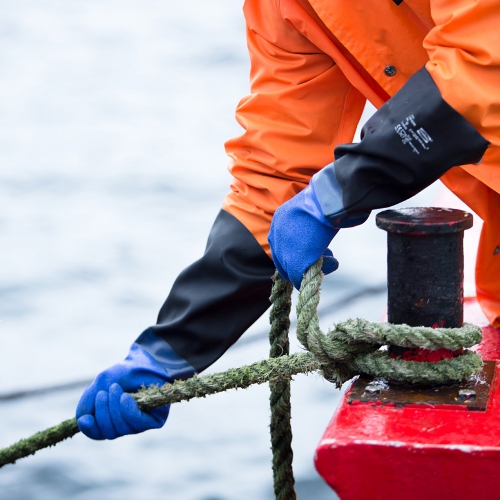STANDARDS AND MARKINGS FOR PROTECTIVE GLOVES

All personal protective equipment is divided into three categories according to the hazards they protect against:
| Category | Level of Protection | PPE Controls | Production control |
| I | Minimum Risks | Manufacturer Own Certifications | Manufacturer is Responsible |
| II | Medium Risks | EC-type Examination from a Notified Body | Manufacturer is Responsible |
| III | Irreversible damage | EC-type Examination from a notified body | Notified Bodies Control Production |
Category I: gloves that provide protection against a minimum risk. Category I gloves comply with EN 420:2003, a standard which confirms that the gloves themselves do not cause harm to the wearer and are comfortable to wear. The pH and the chromium VI content are tested (which requirements include), in addition to water vapour transmission and the absorbency of the materials. The size of the gloves and the mobility of the fingers in the gloves, as well as the general information requirements marked on and accompanying the gloves, are also checked. All gloves sold on the Becky AS website comply with the general requirements of EN 420:2003 and carry CE markings.
Category II: gloves providing protection against medium risk. The gloves comply with the European standard EN 420:2003 and are marked with a performance level indicating how the glove withstood the glove mechanical hazard test according to EN 388:2016 and how this result was obtained. Some gloves protect against specific hazards such as cold (EN 511:2006), direct heat below 100 °C (EN 407:2004) and water (EN 374-2:2003). The level of performance is indicated in ascending order, which means that 0 indicates the least protection. These levels are always indicated in the same order in the pictogram.
Category III: gloves providing protection against irreversible damage. The gloves comply with the European standard EN 420:2003 and are marked with a performance level indicating how well the glove withstood a specific test for some of the hazards, such as direct heat above 100 °C (EN 407:2004) and chemical risk (EN 16523-1:2015).
STANDARDS FOR PROTECTIVE GLOVES

Standard EN 388:2016 + A1:2018 – gloves that protect from mechanical hazards. Protection against mechanical hazards is indicated by a pictogram below which have 5 to 6 performance levels, each number indicates how well the glove protected against a particular hazard in a particular test.
a – Abrasion Resistance (protection level 0-4). This category indicates the number of cycles it took to rub a hole in the sample glove with sandpaper. The higher the level, the more resistant the glove. The best wear resistance is level 4.
b – Cut Protection, Coup test (protection level 0-5). This category indicates the number of cycles it took to cut through the sample glove at a steady speed.
c – Tear Resistance (protection level 0-4). This category indicates how much force was required to break the sample glove.
d – Puncture Resistance (protection level 0-4). This test indicates how much force had to be exerted to make a hole in the glove with a standard size punch. In all cases, the number [0] indicates the lowest level of performance.
| 0 | 1 | 2 | 3 | 4 | 5 | |
| a. Abrasion Resistance (factor) | 100 | 500 | 2000 | 8000 | ||
| b. Cut Protection (factor) | 1,2 | 2,5 | 5,0 | 10,0 | 20,0 | |
| c. Tear Resistance (Newton) | 10 | 25 | 50 | 75 | ||
| d. Puncture Resistance (Newton) | 20 | 60 | 100 | 150 |
e – Cut Resistance, ISO 13997 test (protection levels A-F). The test indicates the force in Newtons (N) required to cut through the sample. The performance levels range from level A cut resistance (applied force 2 N … 5 N) to level F (applied force greater than 30 N).
f – Impact Resistance (protection level P). The impact tests are only carried out on gloves with specific impact resistant elements on the palm, back of the hand or on the knuckles. This test is optional and three possible grades are given: P (passed), F (failed), X (not tested).

EN 511: 2006 – gloves that protect against cold. This standard applies to gloves that protect the hands against convective or direct cold (up to -50 °C). This pictogram indicates protection against cold. Under it are three numbers indicating the level of performance. Each number indicates protection against a different cold-related hazard.
a – Protection Against Convective Cold (0-4). The performance level is measured by the degree to which the glove’s thermal insulation protects the wearer against convective or transmissive cold.
b – Protection Against Contact with a Cold Object (0-4). This performance level indicates the performance of the glove’s blade protection in the event of direct contact with cold objects.
c – Protection Against Water (0 – not water resistant; 1 – water resistant).

EN 407: 2004 – gloves that protect against thermal hazards. The nature and level of the protective characteristics are indicated by a pictogram, with 6 digits below indicating the level of performance, which in turn relates to protection against a specific hazard.
a – Resistance to Flammability (0-4). This is based on the time during which the glove material is still burning or glowing even though the ignition source has been removed. The glove seams must be able to withstand a minimum of 15 seconds.
b – Protection Against Contact Heat (0-4). This is based on a temperature (100 °C to 500 °C) at which the glove wearer feels no pain for at least 15 seconds of exposure. The glove may only be marked level 3 if the performance level is at least level 3. Otherwise, the maximum protection against direct heat remains at level 2.
c – Protection Against Convective Heat (0-4). This is based on the time during which the glove protects the wearer from convective heat. The performance level shall only be indicated if the glove was rated level 3 or 4 in the flammability test.
d – Protection Against Radiant Heat (0-4). This is based on the time during which the glove is able to protect the wearer from heat when the wearer is exposed to radiant heat. The performance level shall only be indicated if the glove achieved level 3 or 4 in the flammability test.
e – Protection Against Small Splashes of Molten Metal (0-4). The number of molten metal splashes that heated the sample glove to the given level. The performance level shall be indicated only if the glove achieved level 3 or 4 in the flammability test. 4.
f – Protection Against Large Molten Metal Splashes (0-4). The amount of molten metal that damaged the skin under the glove. The glove fails the test if the metal splashes remain stuck to the glove or if the glove ignites.
Protection against chemicals.
EN 374-1:2016 + A1:2018 – Standard for protective gloves against hazardous chemicals and micro-organisms. The standard specifies requirements for gloves to protect the user against chemicals and micro-organisms.
EN 374-2:2016 – Resistance to penetration. Gloves that are required to protect against micro-organisms and chemicals must be tight (without holes). The tightness is tested by filling the gloves with water or air. If they allow water or air to pass through, the gloves are inadequate.

EN 374-5: 2016 – Protection Against Micro-Organisms. Gloves with this pictogram protect against bacteria and fungi. If the pictogram is also accompanied by the word “VIRUS”, protection against viruses is added.

EN 16523-1:2015 – Resistance to Penetration by Chemicals. Test method for the measurement of the resistance of a material to penetration by chemicals. Gloves are classified into: Type A, Type B or Type C.
Type A – for at least 6 listed chemicals, penetration > 30 min
Type B – for at least 3 listed chemicals, a penetration time > 30 min
Type C – for at least 1 listed chemical, lead time > 10 min
The pictogram of Type A and Type B chemical resistant gloves shall indicate the code letters of the chemicals tested. Type C labelled gloves shall be without a code letter.
The list of 18 chemicals for which gloves can be tested:
| Code Letters | Chemical | Cas No. | Class |
| A | Methanol | 67-56-1 | Primary Alcohol |
| B | Acetone | 67-64-1 | Ketone |
| C | Acetonitrile | 75-05-8 | Nitrile Compound |
| D | Dichloromethane | 75-09-2 | Chlorinated Hydrocarbon |
| E | Carbon Disulphide | 75-15-0 | Sulphur Containing Organic Compound |
| F | Toulene | 108-88-3 | Aromatic Hydrocarbon |
| G | Diethylamine | 109-89-7 | Amine |
| H | Tetrahydrofuran | 109-99-9 | Heterocyclic and Ether Compound |
| I | Ethyl Acetate | 141-78-6 | Ester |
| J | n-Heptane | 142-85-5 | Saturated Hydrocarbon |
| K | Sodium Hydroxide 40% | 1310-73-2 | Inorganic Base |
| L | Sulphuric Acid 96% | 7664-93-9 | Inorganic Mineral Acid, Oxidizing |
| M | Nitric Acid 65% | 7697-37-2 | Inorganic Mineral Acid |
| N | Acetic Acid 99% | 64-19-7 | Organic Acid |
| O | Ammonium Hydroxide 25% | 1336-21-6 | Organic Base |
| P | Hydrogen Peroxide 33% | 7722-84-1 | Peroxide |
| S | Hydrofluoric Acid 40% | 7664-39-3 | Inorganic Mineral Acid |
| T | Formaldehyde 37% | 50-00-0 | Aldehyde |
Penetration performance indicates the time taken for the hazardous substance to penetrate completely through the glove.
| Protection Index | Measured Breakthrough Time |
| Class 1 | > 10 min |
| Class 2 | > 30 min |
| Class 3 | > 60 min |
| Class 4 | > 120 min |
| Class 5 | > 240 min |
| Class 6 | > 480 min |

CE Food Safety. European legislation on food contact materials (Directive EC1935/2004) requires that these materials must not in any way affect the quality of food items or alter their organoleptic characteristics such as colour, odour, texture or taste. Gloves bearing this label are suitable for working with food.
Read more about standards for protective gloves HERE.
Find all Becky Tööohutuskeskus` work gloves HERE!










Follow us on social media:
Join our mailing list! Sign up to receive email updates on new products, special offers and more.